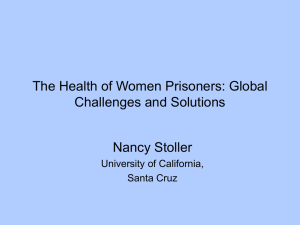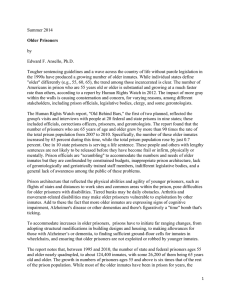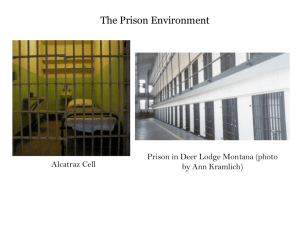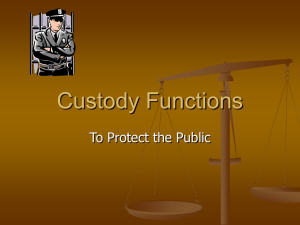the effects of long-term imprisonment
advertisement
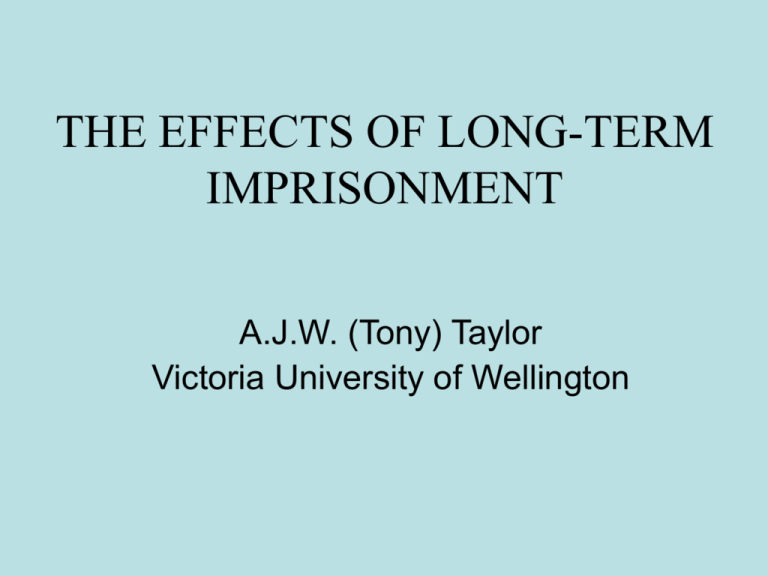
THE EFFECTS OF LONG-TERM IMPRISONMENT A.J.W. (Tony) Taylor Victoria University of Wellington Abstract • Purpose of prisons • – to change the behaviour of the majority of inmates through retaliation or reformation • - to retain the intransigent minority in accordance with basic principles of human rights • - thereby ‘Improving public safety by ensuring sentence compliance and reducing re-offending through capable staff and effective partnerships’ (Dept. of Corrections’ Strategic Business Plan, 2009) • Accountability in the rehabilitative chain The theme • Those who cannot learn from history are doomed to repeat it: and those who do, can select remarkable guides and guidelines - adapted from George Santayana Outline • Unfettered ideology / administrative policy v Academic appraisal • Evolution of prisons • Excessive deprivation compounding other factors • Repeated observations • National and International authorities • A Penal Commission Disputation driven by: • Ideological assertions versus principled accountability • Beliefs and initial gut reactions versus consideration of declared criteria • Reliance on public clamour versus resolute appraisal of data • Assumption that all victims want vengeance all the time versus clinical and survey evidence to the contrary Home Secretary Winston Churchill ‘The mood and temper of the public in regard to the treatment of crime and criminals is one of the most unfailing tests of the civilization of any country. A calm and dispassionate recognition of the rights….even of the convicted criminal against the State,... [and] tireless [efforts] towards the discovery of curative and regenerative processes,… mark and measure the stored up strength of a nation, and are the sign and proof of the living virtue in it’ (House of Commons 20th July 1910) Evolution of prisons • Caves and dungeons in pre-Biblical times • Monastic chambers AD 1084, & Pope Innocent 1143 four rules • Fr. Mabillon mid-17th proposal for laity • 1675 Fr. Fillipo applied riules to y.. in Florence Hospice • 1704 Pope Clement XI created cellular Prison in Rome • Elizabethan Bridewells, transportation, America, Australia, Norfolk Island • Philadelphia, Auburn, Elmira, Pentonville, New Zealand • Modern super-max Transportation • Anglo-Saxon focus…..1615-1785 est. 60,000 to America • 1779 hulks as staging posts ‘most brutalizing… demoralizing, ..horrible’, and fatal - Webbs • 1788-1850s NSW, Van Diemen’s Land, Norfolk Island, WA. est. 16,000 …’imposition of perpetual tyranny and slavery’ – Maconnochie…. a living death.. cf. Henry Garrett (McGill, 2006) • Pentonville opened 1842 • The official report of 1853 recorded 220 cases of insanity, 210 of delusions, and 40 suicides in the 60,000 prisoners that had entered the place • Model for 54 prisons in Britain • Staff training centre – Col Arthur Hume to NZ 1881 • Tyranny of Edmund Du Cane 1869-1896 – deprived prisoners of sleep, made bare rations unpalatable, removed w.c.s from cells, restricted moral and educational instruction. Excessive deprivation • • • • • • • • Personal and social identity, and human rights Isolation Less eligibility implied and confirmed by statute Clothing Food Security Hygiene William Penn, John Howard, Elizabeth Fry, Alexander Maconnochie, Thomas M Osborne, Mary B. Harris, Alexander Paterson Repeated observations In 1846 Dr Lauvergne (cf. Bourdet-Pléville, 1960, p. 70): in the bagnes in the 1830s: – the coarse food, constipation, extremes of heat and cold, the merciless hardness of the guards, and the iron yoke, turn men who are normally stupid and docile into tigers. It is dangerous to leave them for long periods in prey to melancholy…. From these causes stemmed the attacks of despair which often culminated in assaults on guards or the murder of another convict - both offences carrying an inescapable penalty - the guillotine’ Dr Chassinat ‘in the three great bagnes of Toulon, Brest and Rochefort…the death rate [in the period 1822-1837] was at it highest during the first year of captivity, was still considerable during the second year, and diminished steadily afterwards; results he put down to grief, discouragement and the fright inspired by those undergoing the discipline of life in a bagne for the first time’ – (Bourdet-Pleville, 1960, pp. 80-81) Charles Dickens – on the Eastern State Penitentiary Pennsylvania • The prisoner ‘is led to the cell from which he never again comes forth, until his whole term of imprisonment has expired He is a man buried alive; to be dug out in the slow round of years; and in the mean time dead to everything but torturing anxieties and horrible despair’ Prison Chaplain John Graham (1922, p.266) ‘The wearing away of personality is the central effect of prison life…The absence of all choice, of the need or the opportunity to make decisions, resulted in really weakened will-power in some cases when the men at last emerged. They found they could not decide anything, even when to cross the street. It was some time before they ceased to feel like sheep in a flock. The will atrophied’. Clinicians • The Swiss surgeon A.L. Vischer (1919) described the lifeless reaction to captivity among prisoners in solitary confinement, and he recognised it again among groups of POWs of different nationalities during World War 1. • He called it ‘barbed wire disease’, saying that ‘[M]ore than anything else the barbed wire winds like a thread through [the] mental processes’. • He linked the condition to the ‘complete uncertainty of the duration of ‘imprisonment’, and to the lack of sufficient work to help prisoners occupy their time (ibid, p. 31). Solitary confinement The Webbs (1922) • ‘the dreadful experience …did not, in fact, lead to penitence and moral regeneration, but [to the] loss of health, mental depression,…much insanity, repeated attempts at suicide and an appalling death rate ’ GBS preface…. Environmental emphasis • Prisoners and polar explorers : a man going berserk after only two weeks, unwittingly confirmed my expectations when he said: ‘its hard to define…like being locked in a prison. …came down expecting wide open spaces. I get angry and tired… miss the green and the blue something terrible…it makes me unhappy…. .. I would like to see some free water and the sea … there is nothing but endless white and endless black’. Richard Korn (1988) • mental and physical condition of women prisoners in super-max had deteriorated to a critical point – led to controls being increased to protect inmates from each other, staff from them, and public breaking in to release them. Lorna Rhodes (2005) • drew attention to the pathological function of supermax prisons in producing or exacerbating mental illness. She found 20-25% of supermax inmates showed strong evidence of mental illness. • She commented that such places also affect ‘the psychology and self-perception of prisoners, whether or not they can be described as mentally ill’, and they raise ‘broader questions about the larger or “collateral” effects of the US prison complex’. • Their ‘crowded condition, frightening interactions with other inmates, and multitudes of prison rules’ heighten or produce symptoms of anxiety, rage, dissociation, and psychosis. Who said it and when? legislators and prison architects were planning and constructing too many ‘monolithic maximum-security installations’. Even at that time, they saw that the ‘dead hand of the past [demanded] that massive piles of stone concrete and steel with all the modern security gadgets be built even though…only a bare twenty per cent of those sent to prison [required] maximum security. The frenzy for security and custody [was] costing the taxpayer millions of dollars’. Official Inquiries abroad gathering dust • • • • 1883-84 New York Board of Charities 1895 Herbert Gladstone Report 1931 Wickersham Report NZ Royal Commissions/ Ministerial Commissions of Inquiry, Ombudsman’s Reports… Official Reports 1930s and 1940s, Royal Commissions in Britain and Canada acknowledged mental deterioration in prisoners but regarded it as unacceptable In 1943 the International Red Cross Committee (IRCC) recognised the condition in prisoners of war when recommending priority in repatriation be given to those ‘whose mental and physical condition appears to be endangered by prolonged imprisonment, and to the ‘aged prisoners who have endured long imprisonment’ Latest authoritative appraisals • In 2002, the European Parliament made a forthright condemnation of ‘the material condition, limited human contact, and special conditions that were likely to exacerbate the deleterious effects inherent in long-term imprisonment’. • In 2005 The WHO Health in Prisons Project also noted that there was ‘complete agreement that the public health importance of prisoner health was sadly neglected throughout Europe’ Conclusion • Societies that profess to be more humanitarian than barbaric should constantly monitor their treatment of captives. • New Zealand has already done so with regard to the care of the mentally ill and children in need of care and protection. It needs to do the same for criminals if it is properly to protect their potential victim/casualties and the taxpayers. • Conceivably an independent Penal Commission might help Parliament and the country to do that.








